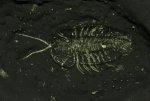
| Palaeos: |  |
Trilobita |
| Arthropoda | Ptychopariida |
| Page Back | Unit Up: Arthropoda | Glossary | Page Next |
| Unit Back: Arachnida | Unit Home: Trilobita | References | Unit Next Mandibulata |
| Class Trilobita Order Agnostida Order Redlichiida Order Corynexochida Order Phacopida Order Lichida Order Proetida Order Harpetida Order Ptychopariida Order Asaphida Order Odontopleurida Order Nectaspida |
Trilobites
Trilobite Systematics and Taxonomy Trilobites Through Geologic Time Trilobite Gallery Glossary References |
 Ptychopariida (pronounced Pity-cho-pa-ree-da) is a huge and morphologically diverse order of trilobite that has largely defied science's attempts to unravel its phylogeny through cladistics. Many ptychopariids were among the most primitive trilobites dating to the early Cambrian. The order persisted through to the late Ordovician. Fortey (2001), posited that Ptychopariida arose out of the paraphyletic suborder Redlichiina. Ptychopariida is a critical grouping in that the order likely gave rise to the great plurality of post-Cambrian trilobites (Edgecombe, 1992; Eldredge, 1977; Fortey and Chatterton, 1988; Fortey and Owens, 1997; Fortey, 2001; Jell and Adrain, 2003). Order Ptychopariida is often described as a catch-all bucket for trilobites from the middle through upper Cambrian.
Ptychopariida (pronounced Pity-cho-pa-ree-da) is a huge and morphologically diverse order of trilobite that has largely defied science's attempts to unravel its phylogeny through cladistics. Many ptychopariids were among the most primitive trilobites dating to the early Cambrian. The order persisted through to the late Ordovician. Fortey (2001), posited that Ptychopariida arose out of the paraphyletic suborder Redlichiina. Ptychopariida is a critical grouping in that the order likely gave rise to the great plurality of post-Cambrian trilobites (Edgecombe, 1992; Eldredge, 1977; Fortey and Chatterton, 1988; Fortey and Owens, 1997; Fortey, 2001; Jell and Adrain, 2003). Order Ptychopariida is often described as a catch-all bucket for trilobites from the middle through upper Cambrian.
Interestingly, there has been some speculation that diminitive trilobites of order Agnostida may have evolved as a offshoot of the Ptychopariida due to progenesis, the retention by an organism of juvenile or even larval traits into later life.
What are now trilobite Orders Ptychopariida, Asaphida, Proetida, and Harpetida were grouped together as Order Ptychopariida in the 1959 Treatise on Invertebrate Paleontology. The subclass Librostoma was erected in 1990 by Fortey (1990) to unite these orders that are allied at least in more primitive genera by a natant hypostomal condition where the Hypostome is free of the anterior doublure, and aligned with anterior edge of glabella. Subsequently, Ebach & McNamara (2002) raised Harpetida to an order status because its members lack a rostral plate and have a marginal facial suture.
The thorax is usually large, much longer than the normally small pygidium and has eight or more segments. In some species the pygidium has a flattish border. Ptychopariida trilobites typically have opisthoparian facial sutures, with a forward angled simple glabella with a rounded front. Order Ptychopariida includes what is arguably the most common trilobite, Elrathia kingii that is prodigious in the House Range of Utah.
References
Ebach, M.C. & K.J. McNamara. 2002. A systematic revision of the family Harpetidae (Trilobita). Records of the Western Australian Museum 21:135-67.
Fortey RA 1990. Ontogeny, hypostome attachment and trilobite classification. Palaeontology 33:529-576.
Fortey RA. 2000 Trilobite! Eyewitness to Evolution. HarperCollins, London.
Fortey RA. 2001. Trilobite systematics: The last 75 years. Journal of Paleontology 75:1141–1151.
Kaesler RL, ed. 1997. Treatise on Invertebrate Paleontology, Part O, Volume 1, revised, Trilobita. Geological Society of America and University of Kansas Press, Lawrence, Kansas.
Levi-Setti R 1993. Trilobites. University of Chicago Press, Chicago.
Virtual Fossil Museum
Ptychopariida Trilobites
Zhang Xiguang & Pratt, B.R. 1999. Early Cambrian trilobite larvae and ontogeny of Ichangia ichangensis Chang, 1957 (Protolenidae) from Henan, China. J. Paleontol. 73: 117-128.
| Page Back | Unit home | Page Top | Page Next |
page MAK111205 RGP 120902
